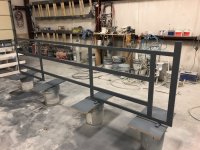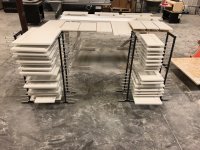1st time poster here. Been reading this site. Great site and great info!
I need some help troubleshooting a problem I'm having when spraying raised panel cabinet doors using gray tinted Kem Aqua plus (Medium Rubbed). The problem I'm having is maybe what "Tom" referred to in a previous post as wet on wet spraying causing "acne looking" blemishes on raised panel cabinet doors. I'm trying to figure out what the preferred sequence is for spraying the raised panel doors; ie. should I spray the outside edge, then the top edges, then the inside where the panel meets the stiles and rails, then the edge of the raised panel, and then the panel itself, or should I spray the area where the panel meets the stiles and rails and then set the doors aside to dry before spraying the rest of the door and panel.
I'm using a fuji Q5 with a T70 bottom cup gun. I've sprayed using both a 1.0 and 1.3 air cap set. The problem seems to be a little worse using the 1.0 however I changed the spray sequence trying to eliminate the problem so the cap size differences may not be really associated with the differing cap sizes. Additionally the general finish appearance is very good with little to no noticeable orange peel. If I could eliminate the "acne" the finish would be near perfect. The "acne" spots almost disappear when the panels dry but I would like to eliminate them completely.
A little additional info, I sprayed the back of the doors which are essentially a flat panel, and I did not get any of the "acne spots" in the finish. Therefore I'm guessing the problem with the raised panels is related to the way I'm spraying them.
All suggestions and help would be greatly appreciated.
Bill
I need some help troubleshooting a problem I'm having when spraying raised panel cabinet doors using gray tinted Kem Aqua plus (Medium Rubbed). The problem I'm having is maybe what "Tom" referred to in a previous post as wet on wet spraying causing "acne looking" blemishes on raised panel cabinet doors. I'm trying to figure out what the preferred sequence is for spraying the raised panel doors; ie. should I spray the outside edge, then the top edges, then the inside where the panel meets the stiles and rails, then the edge of the raised panel, and then the panel itself, or should I spray the area where the panel meets the stiles and rails and then set the doors aside to dry before spraying the rest of the door and panel.
I'm using a fuji Q5 with a T70 bottom cup gun. I've sprayed using both a 1.0 and 1.3 air cap set. The problem seems to be a little worse using the 1.0 however I changed the spray sequence trying to eliminate the problem so the cap size differences may not be really associated with the differing cap sizes. Additionally the general finish appearance is very good with little to no noticeable orange peel. If I could eliminate the "acne" the finish would be near perfect. The "acne" spots almost disappear when the panels dry but I would like to eliminate them completely.
A little additional info, I sprayed the back of the doors which are essentially a flat panel, and I did not get any of the "acne spots" in the finish. Therefore I'm guessing the problem with the raised panels is related to the way I'm spraying them.
All suggestions and help would be greatly appreciated.
Bill


